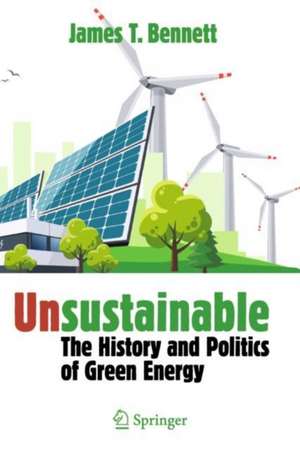Unsustainable: The History and Politics of Green Energy
Autor James T. Bennetten Limba Engleză Paperback – 21 aug 2021
After an in-depth study of the Carter administration's synthetic fuels program, the focus shifts to the two most prominent, perhaps most promising, and certainly most promoted—and government subsidized—“green” and “renewable” energies today: wind and solar. Because wind has made the most headway and drawn the most controversy, it receives the most attention. Although the primary focus is on the American experience with renewable energy, the policies and politics of renewables in Scotland, Wales, Denmark, Spain, and other European nations are also discussed. Issues considered in the book include the nature and efficacy of renewable subsidies; the employment of federal and state tax codes to encourage renewables; the lobbies and interest groups that campaign for government support of renewables; and the fierce battles over the siting of renewable facilities. Unlike other works on this subject, the book probes in depth the nature of the opposition to wind and solar, both in the matter of siting and in their worthiness as recipients of substantial government assistance.
Preț: 180.99 lei
Nou
Puncte Express: 271
Preț estimativ în valută:
34.63€ • 36.23$ • 28.77£
34.63€ • 36.23$ • 28.77£
Carte disponibilă
Livrare economică 12-26 martie
Preluare comenzi: 021 569.72.76
Specificații
ISBN-13: 9783030789039
ISBN-10: 3030789039
Pagini: 250
Ilustrații: VII, 195 p. 1 illus.
Dimensiuni: 155 x 235 mm
Greutate: 0.29 kg
Ediția:1st ed. 2021
Editura: Springer International Publishing
Colecția Springer
Locul publicării:Cham, Switzerland
ISBN-10: 3030789039
Pagini: 250
Ilustrații: VII, 195 p. 1 illus.
Dimensiuni: 155 x 235 mm
Greutate: 0.29 kg
Ediția:1st ed. 2021
Editura: Springer International Publishing
Colecția Springer
Locul publicării:Cham, Switzerland
Cuprins
Table of Contents
Introduction and Overview.- Synthetic Fail.- Everyone Knows It's Windy.- Winds Subside or Wind Subsidies?.- What Could Possibly Go Wrong?.- Whose Backyard? Siting and Fighting over Wind.- Here Comes the Sun.- Epilogue.
Introduction and Overview.- Synthetic Fail.- Everyone Knows It's Windy.- Winds Subside or Wind Subsidies?.- What Could Possibly Go Wrong?.- Whose Backyard? Siting and Fighting over Wind.- Here Comes the Sun.- Epilogue.
Notă biografică
James T. Bennett is Eminent Scholar at George Mason University (USA). He holds William P. Snavely Chair of Political Economy and Public Policy in the Department of Economics and is Director of the John M. Olin Institute for Employment Practice and Policy. Bennett received his Ph.D. from Case Western Reserve University in 1970 and has specialized in research related to public policy issues, the economics of government and bureaucracy, labor unions, and health charities. He is Founder and Senior Associate Editor of the Journal of Labor Research and has published more than 60 articles in professional journals such as the American Economic Review, Review of Economics and Statistics, Policy Review, Public Choice, and Cato Journal. As a prolific author, he has also written dozens of books related to his research interests.
Textul de pe ultima copertă
This book examines the history, politics, and economics of alternative energy. Since the energy crisis of the 1970s, governments around the world have subsidized and otherwise incentivized alternative forms of energy to reduce dependence on fossil fuels. This search has taken on added urgency in the twenty-first century, as the specter of climate change has engendered ambitious state-level renewable portfolio standards, enhanced federal incentives, and inspired “100% renewable” electrical generation targets in such states as Vermont and Hawaii. To save the planet from destruction, wind, solar, and other renewable energy alternatives must replace fossil fuels. But how did we get here and what is the cost?
After an in-depth study of the Carter administration's synthetic fuels program, the focus shifts to the two most prominent, perhaps most promising, and certainly most promoted—and government subsidized—“green” and “renewable” energies today: wind and solar. Because wind has made the most headway and drawn the most controversy, it receives the most attention. Although the primary focus is on the American experience with renewable energy, the policies and politics of renewables in Scotland, Wales, Denmark, Spain, and other European nations are also discussed. Issues considered in the book include the nature and efficacy of renewable subsidies; the employment of federal and state tax codes to encourage renewables; the lobbies and interest groups that campaign for government support of renewables; and the fierce battles over the siting of renewable facilities. Unlike other works on this subject, the book probes in depth the nature of the opposition to wind and solar, both in the matter of siting and in their worthiness as recipients of substantial government assistance.
After an in-depth study of the Carter administration's synthetic fuels program, the focus shifts to the two most prominent, perhaps most promising, and certainly most promoted—and government subsidized—“green” and “renewable” energies today: wind and solar. Because wind has made the most headway and drawn the most controversy, it receives the most attention. Although the primary focus is on the American experience with renewable energy, the policies and politics of renewables in Scotland, Wales, Denmark, Spain, and other European nations are also discussed. Issues considered in the book include the nature and efficacy of renewable subsidies; the employment of federal and state tax codes to encourage renewables; the lobbies and interest groups that campaign for government support of renewables; and the fierce battles over the siting of renewable facilities. Unlike other works on this subject, the book probes in depth the nature of the opposition to wind and solar, both in the matter of siting and in their worthiness as recipients of substantial government assistance.
Caracteristici
Examines the history, politics, and economics of alternative energy Analyzes the current debate over siting and subsidizing wind and solar plants Gives a fair and extensive hearing to critics of these renewable energy technologies
